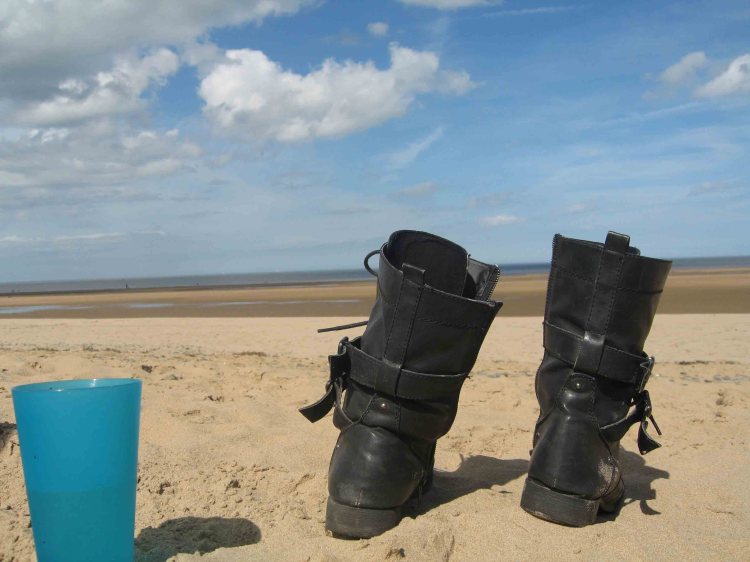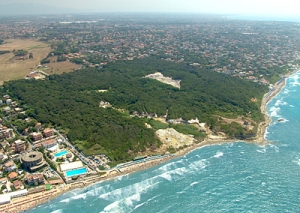
I need to go to the beach at least once a month. To see the sea, to check it’s still there. In the North West of England we’re fortunate to have the North Wales coast and the Wirral within easy drive, both great coastlines, with some excellent beaches for walking or sitting. There’s still something special in the ritual of going to the beach. Gritty sandwiches for lunch, those weird windbreaks that are essentially blankets threaded on poles, the screeching hark of gulls, the distant sigh of waves flopping onto the shore. The hubbub of noise on a busy, sunny day and the family left on the beach, long after everyone else has gone home, frantically digging, because some little tyke has buried daddy’s car keys in the sand, but can’t remember where.
There have been many famous film moments that take place on beaches, from the finned terror of Jaws and the chess game with Death in The Seventh Seal, to the apocalyptic endings of Kiss Me Deadly and Planet of the Apes, the amphibious landing in Saving Private Ryan and the Lancaster-Kerr clinch in From Here to Eternity. The most-photographed beach in film history lies to the west of Rome, on Anzio Cape, though most people won’t have even heard of it. It’s called Tor Caldara and has appeared in literally scores of A and B-movies over the years, including mythical epics such as Hercules and Hercules Unchained, sci-fi movies such as The Day the Sky Exploded and westerns, including Django.

Reserva naturale regionale Tor Caldara – Tor Caldara Nature Reserve – is 44 hectares of beach, an inlet, a sandy clearing and a stream surrounded by woodland oaks, south of Anzio. It also boasts unusual fauna and flora, and is a protected WWF site. There’s a circular medieval watchtower on the headland and the Nature Reserve features sulphurous springs – in some films distinctive yellow strata can be seen in the landscape – which when they are bubbling give the area the smell of rotten eggs. It was one of the beaches used by the Allies during Operation Shingle – the Anzio Landings in Italy in January 1944 – and since then it’s seen plenty of action, both as a popular beauty spot and, especially in the 1960s, as a filming location.
Scenes featuring Tor Caldara can be spotted in Pasolini’s The Gospel According to St Matthew and Medea, and it’s the beach with a defensive German bunker that is assaulted in the low-budget WWII movie Hell in Normandy. It was particularly popular with makers of sword and sandal epics and features in, or is the principle setting for, Hercules Conquers Atlantis, Maciste against the Vampire, Mole Men against the Son of Hercules, Perseus the Invincible, The Giant of Marathon, The Giants of Rome and most prominently in Hercules against the Moon Men. It was later a useful ‘desert’ (with the sea and headland kept well out of shot) in many, many spaghetti westerns, including Texas Adios, Django Shoots First, Vengeance, This Man Can’t Die, Adios Gringo and Johnny Hamlet.
Whenever Italian filmmakers needed a modest stretch of desert and woodland or cliffs and a beach close to their Rome studios, Tor Caldara was the go-to location. The site was particularly popular with directors Mario Bava and Sergio Corbucci. Bava featured scenes at the beach and inlet in Danger: Diabolik, Hercules in the Centre of the Earth (aka Hercules in the Haunted World), the Viking movies Erik the Conqueror and Knives of the Avenger, the horror titles The Whip and the Body, Five Dolls for an August Moon and Shock and extensively in the alleged comedy western Roy Colt & Winchester Jack. Corbucci used the area in a variety of genre films, including the swashbuckler The Man Who Laughs and the Roman epic, Duel of the Titans (aka Romulus and Remus). It also cropped up in several of his westerns, including Ringo and his Golden Pistol (aka Johnny Oro), Navajo Joe and The Hellbenders.
Perhaps the most famous scene shot at Tor Caldara was the opening title sequence to Corbucci’s Django in the winter of 1965-66, with Franco Nero (starring as the eponymous hero) dragging a coffin through the mud and pouring rain. You’d never guess the Mediterranean is only a few hundred yards away, over that rise.
Tor Caldara was also used for Django’s later scenes at the rope bridge – including the infamous moment when Nero has his hands mangled by horses’ hooves – and for the final shootout amid the crosses of desolate Tombstone cemetery.
To read more about the varied films directed by Corbucci and Bava, and many other films discussed here, check out Cinema Italiano: The Complete Guide from Classics to Cult published by I.B. Tauris.